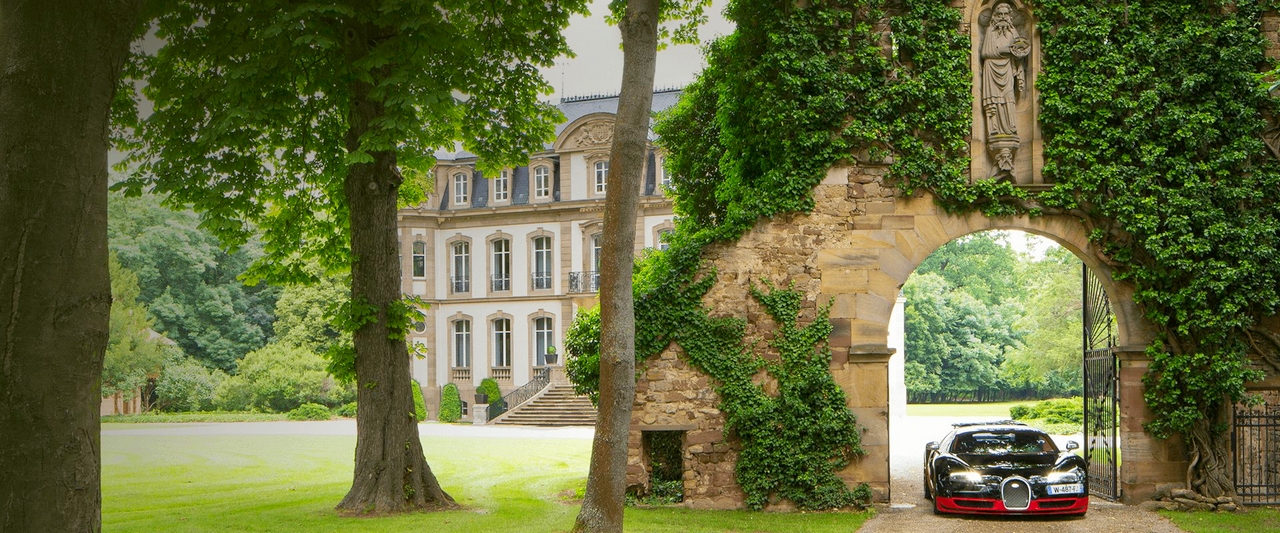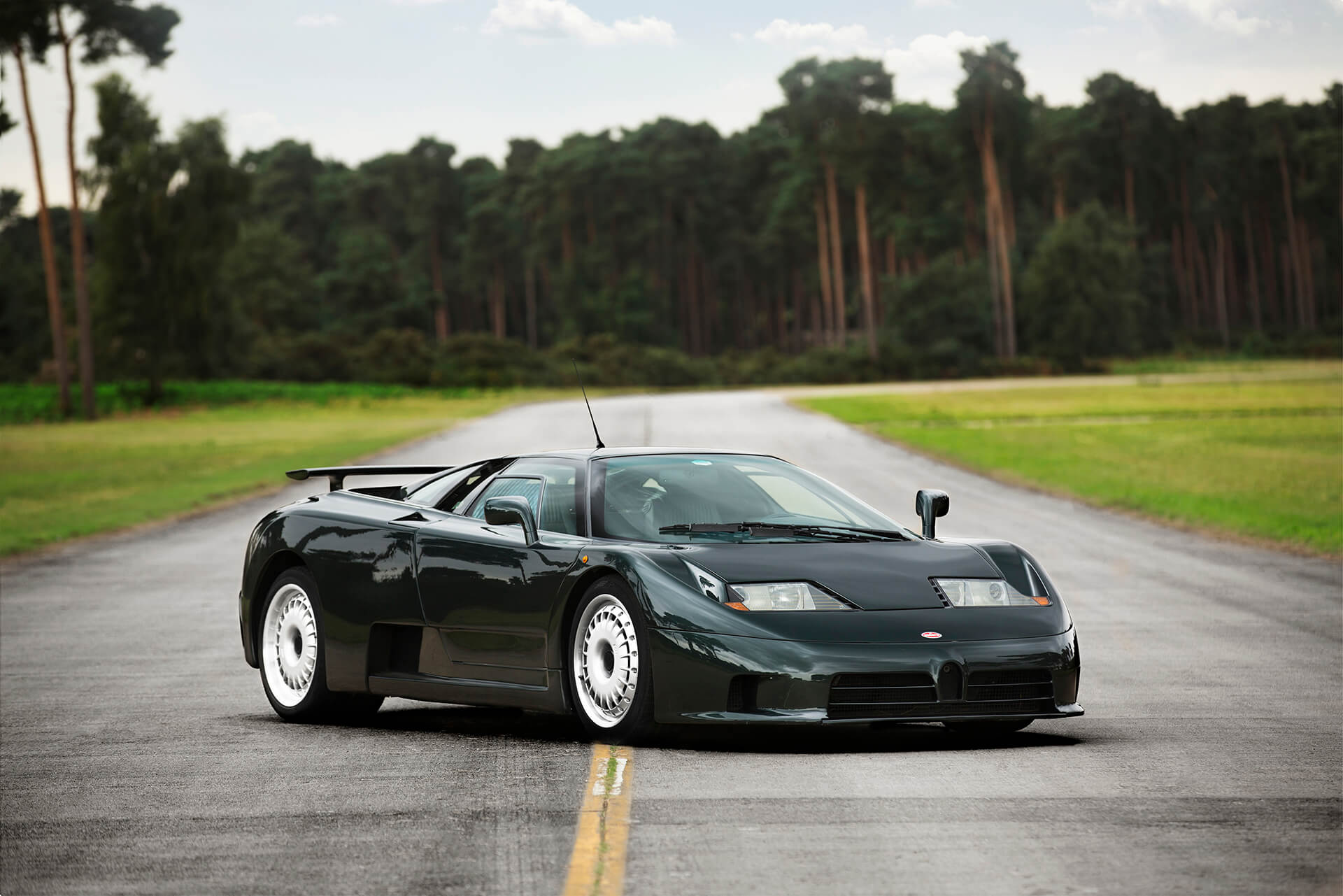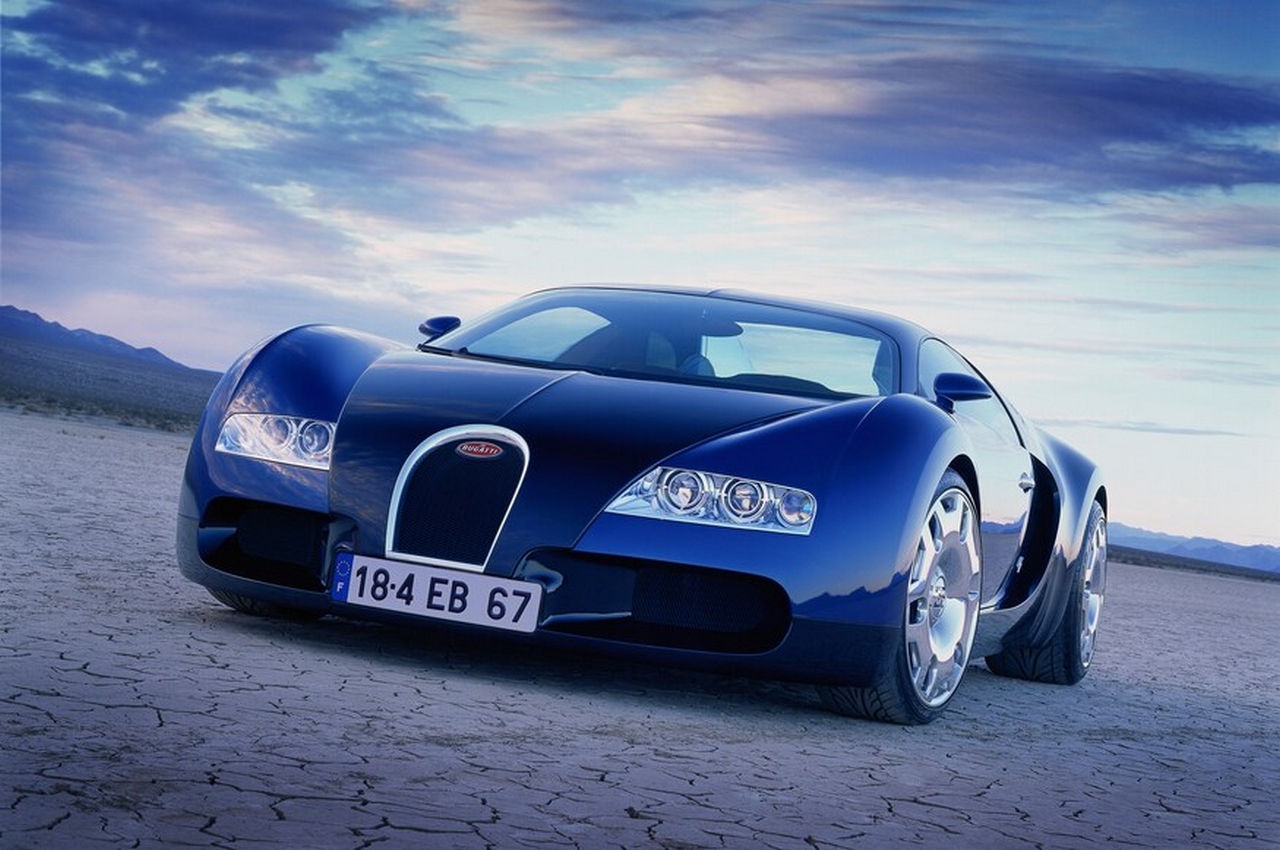The Bugatti Veyron – Origins of the Supercar
Since the birth of the automobile in 1886, when German inventor Karl Benz patented his Benz Patent-Motorwagen, the pursuit to build a better automobile has fueled the imaginations of engineers and designers around the globe. Since the dawn of the 20th century, the vision that fueled those early automotive pioneers to push the envelope of speed and handling has resulted in the creation of some truly remarkable driving machines. Now, at the dawn of the new millenia, the evolution of the “supercar” has given birth to machines that our automotive forefathers could never have imagined.
While the crown of “fastest production car” continues to shift from manufacturer to manufacturer even today, there was a supercar that emerged in the first decade of the 21st century that captured the attention and the imagination of the automotive community and set a whole-new standard of elegance, performance and exclusivity in the supercar market – the Bugatti Veyron.
Before the Veyron – Origins of Bugatti

The Bugatti Veyron is a mid-engined sports car that was first introduced to the world in 2005 by French automobile manufacturer Bugatti. The Veyron, named after French racing driver Pierre Veyron, was designed and developed in Germany by the Volkswagen Group and later manufactured at Bugatti’s assembly plant in Molsheim, France.
To more fully appreciate the origins of the Veyron, it is important to understand the relationship between Volkswagen and Bugatti Automobiles.
Automobiles Ettore Bugatti was a French car manufacturer who specialized in the production of high-performance automobiles. The company, which was founded by Italian-born automobile designer and manufacturer Ettore Arco Isidoro Bugatti in 1909, was known for building some of the fastest, most luxurious and technologically advanced road cars of its day. In fact, Bugatti’s excellent engineering program led to the company’s success in early Grand Prix motor racing, including a Bugatti victory at the first-ever Monaco Grand Prix.

Ettore Bugatti founded his company in the then German town of Molsheim. Although Molsheim is located in the Alsace region of France today, the area was recognized as part of the German empire between 1871 and 1919 and again between 1940 and 1944. Despite being a French city today, the area is predominantly populated by German-speaking citizens.
Bugatti continued to manufacture cars (including such famous Bugatti’s as the Type 41 “Royale”, the Type 57 “Atlantic” and the Type 55 sports car) until his death in 1947. The Bugatti company had already been on a slow financial decline that started (possibly coincidentally) after the death of Ettore’s son, Jean Bugatti in 1939. Without a successor to lead the factory in the wake of Ettore’s passing, there was a great deal of uncertainty as to the company’s future.
The Bugatti Company attempted a brief comeback in the mid-1950’s under the direction of Roland Bugatti Ettore’s twenty-five year old son. During that time, Bugatti manufactured the 1955 Type 251 race car. Unfortunately for all involved, the car failed to perform to the expectations that would-be racers/consumers expected of a Bugatti, and the company ceased production of the car later that same year.

Recognizing the surmounting economic struggles of the company, combined with his own failures in developing successful automobiles, Bugatti instead turned to manufacturing airplane parts until 1963, when the company was sold to Hispano-Suiza, a former automotive manufacturer-turned aircraft supplier.
Bugatti Automobili S.p.A. (1987–1995)
In 1987, Italian entrepreneur Romano Artioli acquired the Bugatti brand and established Bugatti Automobili S.p.A. Artoli commissioned a factory to be built in Campogalliano, Modena, Italy with the sole intent of building the best and fastest supercars in the world. Because Artioli recognized that Modena, Italy possessed many highly-qualified employees (afterall, he built his plant in the neighborhood of Ferrari, Maserati, De Tomaso and Lamborghini), he manufactured a state-of-the-art automobile manufacturing plant there and set to work producing his first car – the Bugatti EB110 GT.

The EB110 GT is, in many respects, a direct predecessor to the Veyron, despite being an Italian engineered and manufactured automobile whose appearance shares only a passing resemblance to the younger car.
While the EB110 had some commercial success internationally, it came to market during a time when both North American and European economies were in recession. Poor sales of their car combined with poor economic conditions globally forced Bugatti S.p.A. to fail. Operations ceased in October, 1995 and the state-of-the-art factory was ultimately sold to a furniture-making company, which itself went defunct prior to physically moving into the factory.
German Engineering and the Birth of the Veyron
Although there is some debate among automotive enthusiasts as to the Veyron’s official country of origin, it is important to note that the car was released under the Bugatti Automobiles marquee, a French high-performance automobile manufacturer. Moreover, the car was physically manufactured in Molsheim, one of the easternmost regions of France. However, it was designed and developed by a team of German engineers and financed under the parent company of Bugatti Automobiles – German-based company Volkswagen AG.
The story of the Bugatti Veyron really begins in May/June, 1998 when Volkswagen AG, at the urging of then-chairman Ferdinand Piech, purchased the rights to produce cars under the Bugatti marquee. Piech had been instrumental in guiding Volkswagen to purchase other luxury marquees including Lamborghini, the Rolls-Royce factory in Crewe, United Kingdom and the Bentley Marque.

At the urging of then-chairman Ferdinand Piëch, Volkswagen purchased the rights to produce cars under the Bugatti marque in June 1998. This followed the earlier Volkswagen purchases of the Lamborghini marque (by VW’s Audi subsidiary), the Rolls-Royce factory in Crewe, United Kingdom, and the Bentley marque. As part of the acquisition, Volkswagen AG purchased the rights to use the Bugatti name and formed Bugatti Automobiles S.A.S. in June, 1999.
Despite the financial collapse of the earlier Bugatti S.p.A. in 1995, Volkswagen A.G. recognized the success of the EB 110 automobile on the world automotive stage and set about developing a series of concept cars whose technological advances would culminate in the creation of the Veyron 16.4.
The first of these concepts was developed between October 1998 and September 1999. Bugatti S.A.S. (or simply Bugatti from here on out) introduced a series of three Giorgetto Giugiaro-designed concept vehicles:
- The EB 118, a 2-door luxury coupe which was first presented at the 1998 Paris Motor Show.

- The EB 218, a 4-door saloon which was first presented at the 1999 Geneva Motor Show.

- The EB 18/3 Chiron, a mid-engine sports car that was first presented at the 1999 International Motor Show in Frankfurt, Germany.

Each of these cars featured a permanent four-wheel drive configuration and each was powered by a Volkswagen designed W18 engine.
While each of these prototypes included elements (most especially the 18/3 Chiron) that would make their way into the production Veyron, it was the EB 18/4 Veyron prototype that most closely resembled the architecture of the actual automobile.
The EB 18/4 Veyron concept vehicle was first introduced in October, 1999 at the Tokyo Motor Show. Developed in-house under the direction of Hartmut Warkuss, the car featured a a three-bank W18 engine (the same engine previously introduced in all three of the earlier Veyron prototypes as well.) The Bugatti EB 18/4 concept became the design study that would eventually lead to the creation of the Bugatti Veyron 16.4 production vehicle in 2005.

In early 2000, a modified version of the EB 18/4, now called the EB 16/4 Veyron, was presented at motor shows in Detroit, Geneva and Paris. This variant of the car featured a four-bank W16 engine architecture, though most of the rest of the car was a carry-forward from the 18/4’s exterior and interior architecture.
In 2001, Bugatti presented a study of the Veyron 16.4 at the IAA in Frankfurt,Germany. This car boasted an output of 1,001 horsepower (736 kW), an eight-liter engine displacement, four turbochargers and a torque of 1,250 Nm. The response to the car was overwhelmingly positive. It was later that same year that the Volkswagen Group made the executive decision to begin production of the Veyron.
Production of the Bugatti Veyron 16.4

It took nearly two years before the first roadworthy prototype of the Bugatti Veyron 16.4 was completed. This earliest production example was identical to other examples of the eventual production model with only a few, minor exceptions. This first car was as much a test-mule for the final product as it was a production prototype that could be introduced to would-be consumers of this ultra-exclusive vehicle.
Because no other automobile had been developed as a direct predecessor of the Veyron (save for the four aforementioned prototypes) there were barely any parts, components or systems that could be used or re-purposed during its development. Everything had to be developed and fabricated from scratch. Moreover, given the incredible performance specifications the Veyron was expected to achieve, all of the inner workings of the car had to be custom-designed to ensure exacting tolerances and achieve the highest level of performance during any driving condition.
The Veyron was developed to meet these specifications:
- Produce over 1,000 horsepower
- Achieve a top speed of over 250 miles per hour (400 kilometers per hour)
- Be able to accelerate from 0-100 in less than three seconds
Above these unprecedented performance specifications (at the time), it was expected that Bugatti would also be capable of producing a super-car that could double as a luxury car suitable for daily driving.
As Volkswagen/Bugatti began to navigate the incredibly complex process of engineering this super-car, they drew on the experiences and knowledge of engineers and designers from other industries including experts in aviation and space travel. It was understood early on that creating such a vehicle would require a team intimately familiar with the extreme forces and speeds that such vehicles as these would require.
Of course, each obstacle in the Veyron’s development eventually led to the creation and/or evolution of technologies needed to breathe life into this amazing machine. Considerable technical problems had to be addressed throughout the car’s transformation from development prototype to true production model, and it would ultimately be another two years before the first Bugatti Veyron EB16.4 would roll off the Molsheim production line.

DID YOU KNOW: The Veyron EB 16.4 was named after Pierre Veyron, who started his career with Bugatti as a development engineer, test driver and company race driver. In 1939, driving with teammate Jean-Pierre Wimille, the pair won the 24 Hours of Le Mans that year behind the wheel of a Bugatti. Additionally, the “EB” in the car’s name actually stands for Bugatti founder Ettore Bugatti while the “16.4” refers to the engine’s 16-cylinder and four (quad) turbochargers.
Bugatti Veyron EB 16.4 (2005)

To quote their website, Bugatti states “the Veyron 16.4 harmoniously combines athletic performance and elegant form, bringing the proud history that is part of the Bugatti-DNA into the present.”
The 2005 Bugatti Veyron featured a classic two-tone design that created a characteristic side-view of the car that is synonymous with earlier vehicles from the company’s past. Similarly, the car’s centerline and horseshoe-shaped radiator grille are throwbacks to the earliest Bugatti racing vehicles. These classic design cues are interlaced with cutting-edge technologies including a retractable spoiler with prominent wings as well as contemporary horizontal headlamps that enhance the car’s unique character.
Mechanically, the Veyron featured an 8.0-litre, quad-turbocharged, W16 cylinder engine. Each cylinder has four valves (totaling 64 valves in-all). Each cylinder bank features two overhead camshafts (four camshafts total). Each camshaft is responsible for driving two banks of cylinders. The engine is fed by four turbochargers and displaces 487.8 cubic inches (7,993 cc) with a square 86mm by 86mm (3.39 inch by 3.39 inch) bore and stroke.

The Veyron’s transmission is a seven-speed, dual-clutch, direct-shift, computer-controlled automatic transmission. The car can be driven in either a semi-automatic or fully-automatic mode. The Veyron features magnesium shifter paddles behind the steering wheel that can allow the driver to manually shift the transmission in semi-automatic mode.
According to the Volkswagen Group, the Veyron’s W16 engine produces 987 horsepower (736 kW, 1,001 PS) and generates 922 lb./ft. (1,250 Nm) of torque. German officials recorded the Veyron’s top speed at 253.81 miles per hour (avg.) during test sessions on April 19, 2005 at Volkswagen Group’s private Ehra-Lessien test track. However, the car’s “normal” top speed is listed at 213 mph (343 km/h).
Whenever the Veyron reaches a speed of 137 mph (or more), the hydraulic suspension lowers the car until it has a ground clearance of approximately 3.5 inches (9 cm). At the same time, the car’s wing and spoiler deploy, generating 770 lbs/ft of downforce to keep the car on the road.
Other Iterations of the Bugatti Veyron
Bugatti Veyron Pur Sang (2007)

Just five of the Bugatti Veyron Pur Sang were manufactured. Each car was priced at approximately $1.94 million dollars each. The car features a number of weight saving features that reduced the car’s weight by roughly 200 pounds. The Bugatti Veyron’s Pur Sang (Pur Sang literally means “Pure Blood”) most notable feature is the car’s unpainted aluminum body panels and exposed carbon fiber composite components.
Bugatti Veyron Fbg Par Hermes (2008)

The Bugatti Veyron Fbg par Hermes is the product of a collaborative effort between Bugatti and the Parisian luxury brand Hermes. The name of this highly exclusive model references the main Hermes store on the Rude Du Faubourg Saint-Honore in Paris. The car was designed to represent the perfect blend of the technical and aesthetic finesse of Emile Hermes and Ettore Bugatti.
The Bugatti Veyron Fbg par Hermes was limited to just four units, although a Veyron 16.4 Grand Sport was later produced in the same configuration.
Bugatti Veyron Sang Noir (2008)

Based on the ‘Pur Sang’, the ‘Sang Noir’ (black blood), features an all-black exterior finish paired with a bright orange interior. Just 12 examples were produced.
Bugatti Veyron 16.4 Grand Sport (2008)

In 2008, Bugatti introduced the Veyron 16.4 Grand Sport edition at the 2008 Pebble Beach Concours d’Elegance. The car featured a targa-top. To compensate for the lack of a standard roof assembly, the car had a number of reinforcements integrated into its body/chassis. It also received a number of small refinements to its running lights and windshield assembly.
Each Grand Sport model came with two removable tops – a color matched hardtop and a canvas-fashioned temporary top that can be opened and collapsed like an umbrella. When the hardtop roof was installed, the Bugatti Veyron Grand Sport edition had the same top-speed as the coupe. However, with the top removed, the car’s top-end acceleration was limited to 229 mph (369 km/h). Additionally, when the temporary soft-top was in-place, the car’s top-speed was limited to just 81 mph (130 km/h).
A total of 150 Grand Sport models were produced, with the first 50 going exclusively to registered Bugatti customers.
Bugatti Veyron Grand Sport Sang Blanc (2010)

Bugatti Veyron 16.4 Super Sport (2011)

While it’s hard to imagine the need for an even faster variant of this incredible super car, the engineers behind the Veyron developed a faster, more powerful version known as the Bugatti Veyron 16.4 Super Sport.
Although limited to a production run of just 30 units, the announcement of the Super Sport garnered an immediate following and the car sold out quickly.
The Super Sport featured a revised W16 engine that increased the engine power output of the standard Veyron to 1,184 horsepower (883 kW, 1,200 PS) at 6,400 rpm and a maximum torque of 1,106 lb/ft of torque at 3,000 rpm to 5,000 rpm. The car also received a revised aerodynamics package. This setup allowed the car to reach a top speed of 267.856 mph (431.072 km/h) which made it the fastest production car at the time of its introduction.




